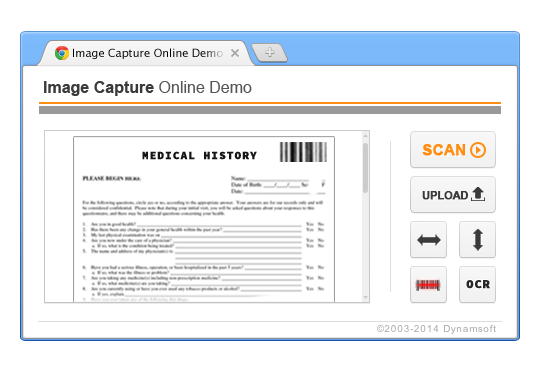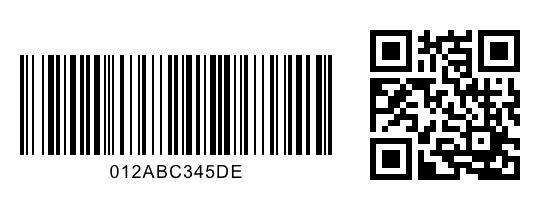5 Tips for Barcode Development in Healthcare
Barcode Use in Healthcare Document Management Systems is Growing: Here are Some Things to Consider When Developing Barcode Technology for Medical Records Software
By Catherine Sea, Customer Service Manager, Dynamsoft
 The use of barcodes in healthcare markets has been advocated going back to the 1970s. The Healthcare Information and Management Systems Society (HIMSS) has emphasized a high priority on using barcode technology to reduce medical errors for better patient safety. The technology has helped solve many human errors. For example, the US Department of Health and Human Services has stated the use of barcodes has reduced medication error rates by as much as 85 percent. To those in the barcode industry, it is well known that the technology helps improve workflow and efficiency. This is true across a myriad of industries, but in the medical field it can also help save lives. So, what do technical staff need to consider to ensure a successful implementation of barcode technology in their healthcare practice?
The use of barcodes in healthcare markets has been advocated going back to the 1970s. The Healthcare Information and Management Systems Society (HIMSS) has emphasized a high priority on using barcode technology to reduce medical errors for better patient safety. The technology has helped solve many human errors. For example, the US Department of Health and Human Services has stated the use of barcodes has reduced medication error rates by as much as 85 percent. To those in the barcode industry, it is well known that the technology helps improve workflow and efficiency. This is true across a myriad of industries, but in the medical field it can also help save lives. So, what do technical staff need to consider to ensure a successful implementation of barcode technology in their healthcare practice?
This article will detail five tips for implementing barcodes in medical records management applications. This includes managing documents such as order requisitions, test results, and patient charts / medical records. The tips will cover technical and workflow considerations.
Really understand the software platform
Learn the detailed platform requirements of the Electronic Health Records (EHR) system you use or plan to use. This includes any desktop, web or mobile application, or combination of any of these. For an example, let’s look at a potential platform requirement for a web-based application. If it’s web-based, you’ll want to identify what browser types the application needs to support. This includes determining if users will be required to maintain a minimum browser type or version. For example, will your web-based application work only on IE version 9 or later? Or, is it important that you support other browsers too: Chrome, Firefox, Safari, Opera, and so on? Ensuring support for browsers will help guarantee continuous workflow and reduce support issues. Once you understand this requirement you can proceed with a corresponding barcode application programming interface (API) to save you development time. There are some open source barcode libraries available. A popular one is ZXing, also known as “Zebra Crossing”). You might instead opt for a third party barcode software development kit (SDK). Commercial SDKs typically provide better barcode processing results, wider barcode type support, and better customer service. Obviously they can also save on development time and costs versus researching, understanding, identifying, creating and supporting an API you built in-house.
Identify the barcode type to use
1D barcodes are widely used in hospitals for purposes such as identifying medications or prices. However, there is a growing need for barcodes to store more and more data. There is also a trend to make barcodes more apt for mobile usage. So, these two new requirements today have many looking to adopt 2D barcodes in healthcare practices too. Compared to linear 1D barcodes, 2D barcodes have the advantage of more memory capacity and storing more information types within less barcode space. Obviously, this makes 2D barcodes more convenient for mobile scans. Whichever you opt for, make sure you properly analyze your requirements to cover all workflow needs. Sometimes, a specific barcode type can work for many applications while other times, different barcode types may be needed for different usage scenarios. When deciding the barcode type, you must also research barcode scanning devices that support each. Some old barcode scanner models may not work with 2D barcodes.
Your image matters
Image is everything, so they say. When it comes to barcodes, it really is. The quality of the barcode image is  important for better accuracy of barcode recognition. It’s known that when scanning documents with barcodes, a resolution of 300 dpi or above is recommended. Make sure you don’t reduce image quality to save space at the expense of disrupting data quality or workflow optimizations. Also, make sure the barcode is complete when scanning the documents – seems like a no-brainer but, it happens. Besides image quality, it’s a good idea to allow users to verify scanned data and manually correct it in cases where errors are found. This is a particularly important step to consider in any EHR workflow.
important for better accuracy of barcode recognition. It’s known that when scanning documents with barcodes, a resolution of 300 dpi or above is recommended. Make sure you don’t reduce image quality to save space at the expense of disrupting data quality or workflow optimizations. Also, make sure the barcode is complete when scanning the documents – seems like a no-brainer but, it happens. Besides image quality, it’s a good idea to allow users to verify scanned data and manually correct it in cases where errors are found. This is a particularly important step to consider in any EHR workflow.
Optimize for performance
When developing an application, how it performs what it’s supposed to do is also paramount – another no-brainer. So, what are some pointers to get better barcode recognition performance? First, if you know you will be using a certain barcode type, pre-specify it within the code of your application. This will save time in your application process to not have to perform a check for a barcode type. It also adds assurance against incorrect barcode type auto-selections. Here’s another tip specific to optimizing workflow performance: Let’s say your users regularly utilize certain form layouts where the barcode is in some fixed area of a document. It’s a good idea to pre-identify the rough barcode area within your application code. So, if you only need to decode one barcode in a document, then specify this and where it is in your code. This saves time and effort in the barcode application trying to locate where the barcode is or if there are more. These small considerations can add up to significantly improve barcode reading performance and workflow.
Thorough analysis and testing
Any good software developer understands you’ve got to be sure what you created works, so analysis and testing of the application is important. You want to try to uncover potential problems. It helps to get different departments involved such as doctors, pharmacists, nurses, and IT during pre and post development of the solution. One basic testing point is to ensure platform compatibility, which means properly determining that the application supports all the required user platforms and devices. This might include workstations, browsers, flatbed scanners or webcams, and more. For other hardware you obviously want to ensure barcode scanner compatibility. This means you want to ensure your barcode scanner devices are able to read the barcode images and properly pass the data to your EHR system. Finally, you must test data transfer workflows. This includes making sure the data from barcodes can be successfully added/updated to an EHR database.
For decades, the healthcare industry has been a leading adopter of barcode technology. It’s arguable that no other industry has benefited more from barcode technologies. These five tips may be applicable to other high-use mission-critical barcode applications, such as government and retail. But, it’s also arguable no one has more at stake than healthcare practitioners if barcode technology is improperly implemented. In healthcare, it’s a vital technology to get correct.
Author bio: Catherine Sea is the customer service manager for Dynamsoft. She regularly blogs to provide tutorials on TWAIN, image capture application, and version control best practices. She has also been a consultant to programmers working with them to develop document capture and management applications. http://www.dynamsoft.com/.
Other articles about barcodes and RFID in healthcare that may interest you:
